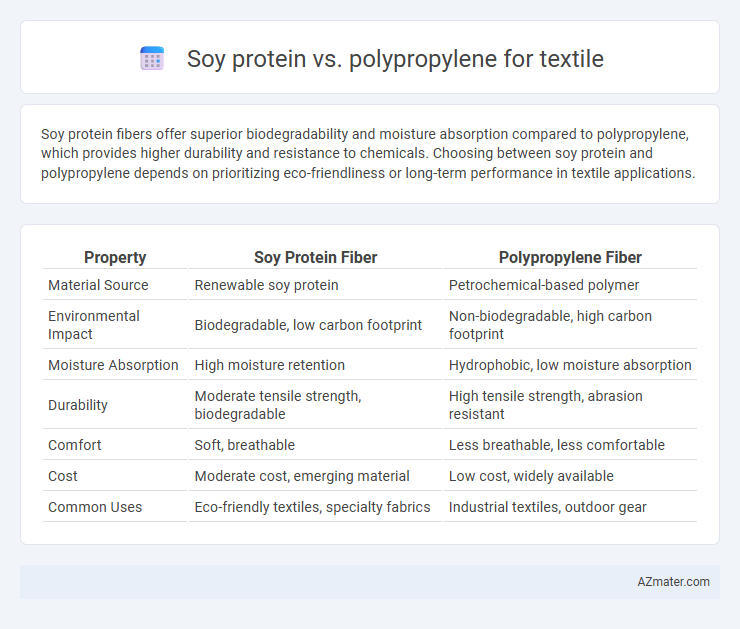Soy protein fibers offer superior biodegradability and moisture absorption compared to polypropylene, which provides higher durability and resistance to chemicals. Choosing between soy protein and polypropylene depends on prioritizing eco-friendliness or long-term performance in textile applications.
Table of Comparison
| Property | Soy Protein Fiber | Polypropylene Fiber |
|---|---|---|
| Material Source | Renewable soy protein | Petrochemical-based polymer |
| Environmental Impact | Biodegradable, low carbon footprint | Non-biodegradable, high carbon footprint |
| Moisture Absorption | High moisture retention | Hydrophobic, low moisture absorption |
| Durability | Moderate tensile strength, biodegradable | High tensile strength, abrasion resistant |
| Comfort | Soft, breathable | Less breathable, less comfortable |
| Cost | Moderate cost, emerging material | Low cost, widely available |
| Common Uses | Eco-friendly textiles, specialty fabrics | Industrial textiles, outdoor gear |
Introduction: Comparing Soy Protein and Polypropylene in Textiles
Soy protein fibers, derived from renewable plant sources, offer biodegradability and natural moisture-wicking properties in textile applications. Polypropylene, a synthetic polymer, is valued for its durability, chemical resistance, and lightweight characteristics in fabric production. Comparing these materials highlights the balance between sustainability benefits of soy protein and performance advantages of polypropylene in textile manufacturing.
Overview of Soy Protein Fiber: Origins and Properties
Soy protein fiber, derived from defatted soybean flakes through a wet-spinning process, is a sustainable and biodegradable alternative in textile production. Its natural origin provides excellent moisture absorption, softness, and antimicrobial properties, making it suitable for eco-friendly apparel and home textiles. Unlike polypropylene, soy protein fiber offers enhanced comfort and environmental benefits due to its renewable sourcing and biodegradability.
Polypropylene Fiber: Features and Applications
Polypropylene fiber is a lightweight, durable synthetic material known for its excellent moisture-wicking properties and resistance to chemicals and abrasion, making it ideal for high-performance textiles. Unlike soy protein fibers, which are biodegradable and derived from natural sources, polypropylene fibers excel in industrial applications such as geotextiles, upholstery, and activewear due to their strength and hydrophobic nature. Its thermal insulation capabilities and quick-drying features further expand its use in outdoor and sports apparel.
Sustainability: Environmental Impact of Both Fibers
Soy protein fibers, derived from renewable plant sources, offer a biodegradable and low-carbon footprint alternative to synthetic polypropylene, which is petroleum-based and non-biodegradable, contributing to microplastic pollution. The production of soy protein textiles consumes less energy and water compared to polypropylene manufacturing, reducing overall environmental impact. End-of-life disposal favors soy protein fibers due to their compostability, contrasting with polypropylene's persistence in ecosystems and challenges in recycling.
Mechanical Properties: Strength, Durability, and Performance
Soy protein fibers exhibit moderate tensile strength and excellent biodegradability, making them suitable for eco-friendly textile applications with reasonable durability. Polypropylene fibers demonstrate superior mechanical strength, high abrasion resistance, and excellent chemical stability, which contribute to their long-lasting performance in industrial and consumer textiles. While polypropylene outperforms soy protein in mechanical robustness and durability, soy protein offers sustainable advantages with acceptable mechanical properties for lightweight, biodegradable textile solutions.
Comfort and Wearability: Breathability, Moisture, and Softness
Soy protein fibers exhibit superior breathability and moisture absorption compared to polypropylene, contributing to enhanced comfort in textile applications. The natural protein structure of soy fibers allows for excellent moisture-wicking properties and softness, making garments feel gentle on the skin. In contrast, polypropylene, a synthetic polymer, is less breathable and retains moisture, which can reduce wearability and cause discomfort during prolonged use.
Dyeability and Aesthetic Qualities
Soy protein fibers exhibit superior dyeability compared to polypropylene due to their natural amino acid structures that readily bind with various dyes, resulting in vibrant and long-lasting colors. Polypropylene, a synthetic polymer, has low dye affinity and often requires special treatments or solution dyeing techniques to achieve acceptable coloration, limiting its color range and intensity. In terms of aesthetic qualities, soy protein fibers offer a softer, more natural texture and a matte finish, while polypropylene provides a smooth, lightweight, and somewhat shiny surface that can feel less breathable and less comfortable against the skin.
Cost Analysis: Production and Market Trends
Soy protein-based textiles exhibit higher initial production costs due to complex extraction and purification processes, whereas polypropylene benefits from established, cost-efficient synthetic manufacturing with lower raw material expenses. Market trends indicate increasing demand for sustainable materials like soy protein, driving investments and potential cost reductions, while polypropylene remains favored for its durability and affordability in mass production. Cost analysis reveals soy protein's premium pricing aligned with eco-conscious consumer segments, contrasting with polypropylene's competitive advantage in volume-driven pricing.
Biodegradability and End-of-Life Considerations
Soy protein-based textiles offer superior biodegradability compared to polypropylene, breaking down naturally in composting environments within months. Polypropylene fibers, derived from petrochemicals, resist degradation and persist in landfills for decades, contributing to microplastic pollution. End-of-life strategies for soy protein textiles often include composting and recycling, while polypropylene typically requires energy-intensive recycling or disposal in incineration facilities.
Future Prospects: Innovations and Market Adoption
Soy protein-based fibers exhibit promising sustainability and biodegradability advantages over polypropylene in textiles, aligning with growing eco-conscious consumer demand. Innovations in soy protein modification and blending techniques enhance fabric durability, softness, and moisture management, driving increased market adoption. Industry trends indicate expanding investment in bio-based fibers, positioning soy protein as a competitive alternative to conventional polypropylene in future textile applications.

Infographic: Soy protein vs Polypropylene for Textile
 azmater.com
azmater.com